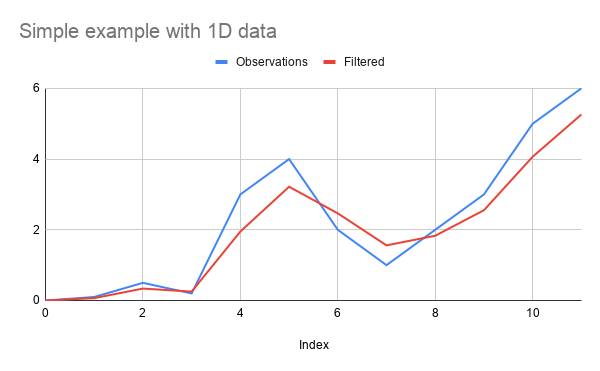kalman-filter
Kalman Filter in JavaScript (for both node.js and the browser)
This library implements following features:
- N-dimensional Kalman Filter (for multivariate Gaussian)
- Forward Kalman Filter (Online)
- Forward-Backward Smoothing Kalman Filter
- Split Prediction/Correction steps
- Extended Kalman Filter
- Correlation Matrix
Demos/Examples
| Link | Description | Image |
|---|---|---|
| Bikes | 4D Constant Acceleration boxes | 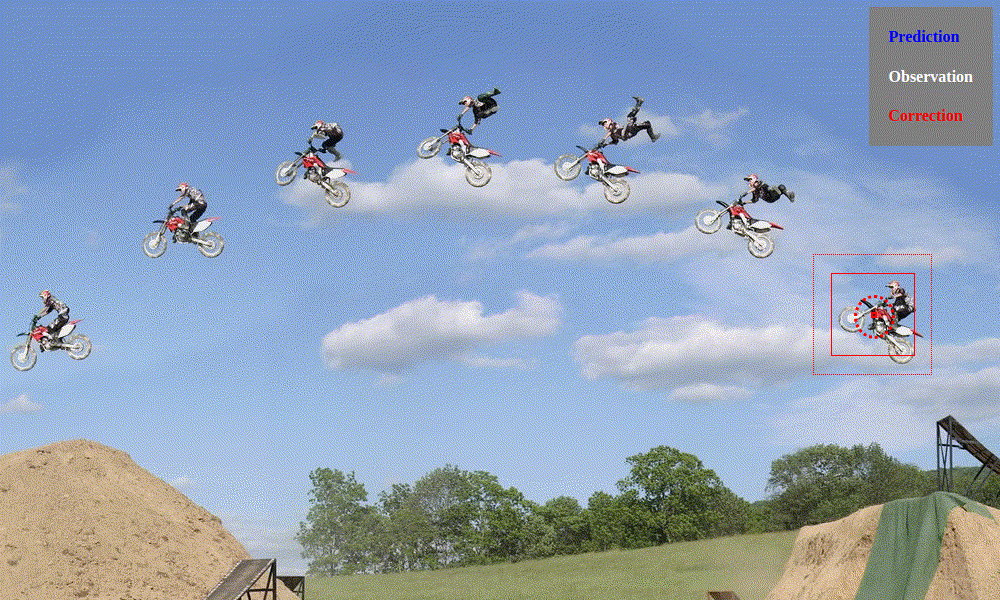 |
| Bouncing Ball | 2D constant acceleration with bounces | 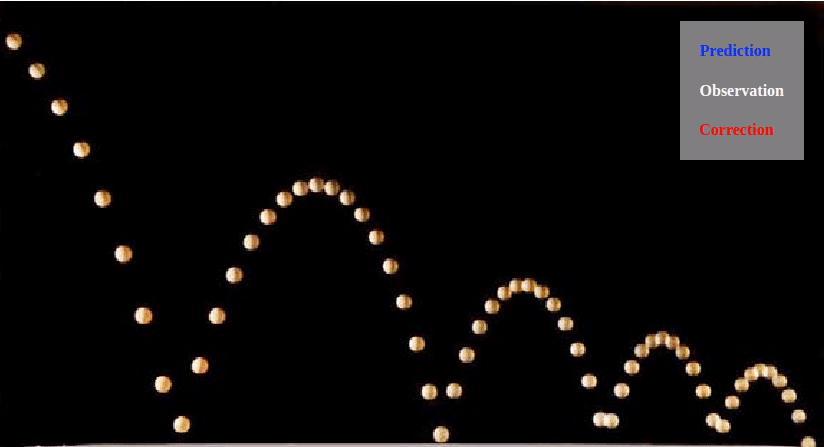 |
| Sinusoidale Extended Kalman-Filter | 1D Extended KF Sinus | 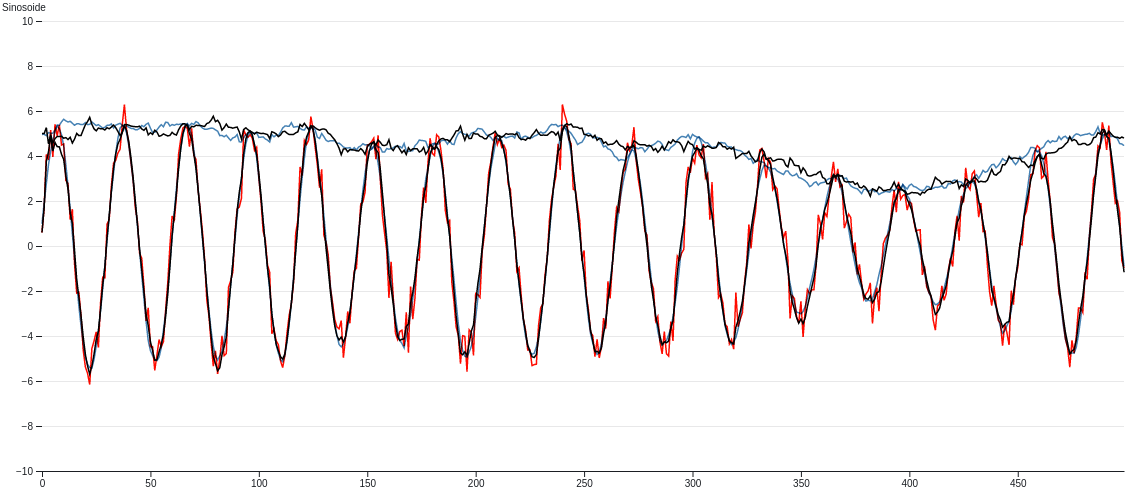 |
| Code pen GPS Data smoothing with constant speed | 2D constant speed | 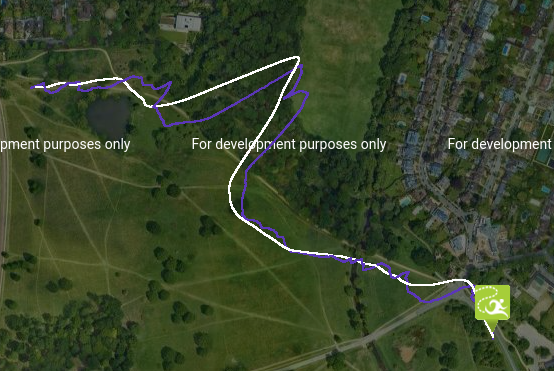 |
| Partial Observation | 1D / 2 sensor with missing values | 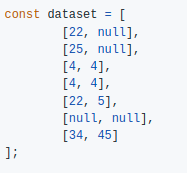 |
| Smooth 3x3 rotation matrix | 4d smoothing | 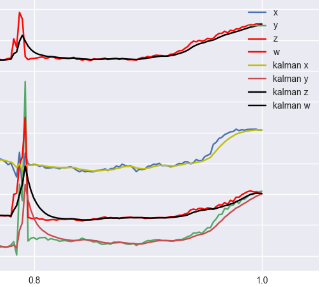 |
Open an issue to add more examples in this section explaining how you use this library !
Installation
Npm
npm install kalman-filterconst {KalmanFilter} = require('kalman-filter');Browser usage
Download the file kalman-filter.min.js from Releases page
Add it to your project like :
<script src="dist/kalman-filter.min.js"></script>
<script>
var {KalmanFilter} = kalmanFilter;
// ... do whatever you want with KalmanFilter
</script>Simple Example
1D Smoothing Usage
const {KalmanFilter} = require('kalman-filter');
const observations = [0, 0.1, 0.5, 0.2, 3, 4, 2, 1, 2, 3, 5, 6];
// this is creating a smoothing
const kFilter = new KalmanFilter();
const res = kFilter.filterAll(observations)
// res is a list of list (for multidimensional filters)
// [
// [ 0 ],
// [ 0.06666665555510715 ],
// [ 0.3374999890620582 ],
// [ 0.25238094852592136 ],
// [ 1.9509090885288296 ],
// [ 3.2173611101031616 ],
// [ 2.4649867370240965 ],
// [ 1.5595744679428254 ],
// [ 1.831772445766021 ],
// [ 2.5537767922925685 ],
// [ 4.065625882212133 ],
// [ 5.26113483436549 ]
// ]Result is :
2D Smoothing Usage
const {KalmanFilter} = require('kalman-filter');
const observations = [[0, 1], [0.1, 0.5], [0.2, 3], [4, 2], [1, 2]];
const kFilter = new KalmanFilter({observation: 2});
// equivalent to
// new KalmanFilter({
// observation: {
// name: 'sensor',
// sensorDimension: 2
// }
// });
const res = kFilter.filterAll(observations)2D Smoothing with constant-speed model
const {KalmanFilter} = require('kalman-filter');
const observations = [[0, 1], [0.1, 0.5], [0.2, 3], [4, 2], [1, 2]];
const kFilter = new KalmanFilter({
observation: 2,
dynamic: 'constant-speed'
});
// equivalent to
// new KalmanFilter({
// observation: {
// name: 'sensor',
// sensorDimension: 2
// },
// dynamic: {
// name: 'constant-speed'
// },
// });
const res = kFilter.filterAll(observations)How to instantiate your kalman filter
Advanced usage
This library gives you the ability to fully configure your kalman-filter.
For advanced usage, here is the correspondance table with the matrix name of the wikipedia article
| Wikipedia article | kalman-filter js lib |
|---|---|
| $F_k$, the state-transition model | dynamic.transition |
| $H_k$, the observation model | observation.stateProjection |
| $Q_k$, the covariance of the process noise | dynamic.covariance |
| $R_k$, the covariance of the observation noise | observation.covariance |
| $B_k u_k$, the control-input model multiplied by the control vector | dynamic.constant |
| $\mathbf{P}_{0\mid 0}$ | dynamic.init.covariance |
| $\mathbf{x}_{0\mid 0}$ | dynamic.init.mean |
Configure the dynamic with dynamic.name
dynamic.name is a shortcut to give you access to preconfigured dynamic models, you can also register your own shortcust see Register models shortcuts
Available default models as :
- constant-position
- constant-speed
- constant-acceleration
This will automatically configure the dynamic.transition matrix.
constant-position
\begin{align}
State :& \begin{bmatrix} x_t \end{bmatrix}\\
Transition Equation :& x_t \sim x_{t-1} \\
dynamic.transition :& \begin{bmatrix} 1 \end{bmatrix}
\end{align}
constant-speed
\begin{align}
State :& \begin{bmatrix} x_t \\ speed_t \end{bmatrix} \\
Transition Equation :&
\begin{split}
x_t &\sim x_{t-1} + speed_{t-1},\\
speed_t &\sim speed_{t-1}
\end{split} \\
dynamic.transition :& \begin{bmatrix} 1 & 1 \\ 0 & 1 \end{bmatrix}
\end{align}
constant-acceleration
\begin{align}
State :& \begin{bmatrix} x_t \\ speed_t \\ acc_t \end{bmatrix} \\
Transition Equation :&
\begin{split}
x_t &\sim x_{t-1} + speed_{t-1} \\
speed_t &\sim speed_{t-1} + acc_{t-1} \\
acc_t &\sim acc_{t-1}
\end{split} \\
dynamic.transition :& \begin{bmatrix} 1 & 1 & 0 \\ 0 & 1 & 1 \\ 0 & 0 & 1\end{bmatrix}
\end{align}
'constant-position' on 2D data
This is the default behavior
const {KalmanFilter} = require('kalman-filter');
const kFilter = new KalmanFilter({
observation: {
sensorDimension: 2,
name: 'sensor'
},
dynamic: {
name: 'constant-position',// observation.sensorDimension == dynamic.dimension
covariance: [3, 4]// equivalent to diag([3, 4])
}
});'constant-speed' on 3D data
const {KalmanFilter} = require('kalman-filter');
const kFilter = new KalmanFilter({
observation: {
sensorDimension: 3,
name: 'sensor'
},
dynamic: {
name: 'constant-speed',// observation.sensorDimension * 2 == state.dimension
timeStep: 0.1,
covariance: [3, 3, 3, 4, 4, 4]// equivalent to diag([3, 3, 3, 4, 4, 4])
}
});'constant-acceleration' on 2D data
const {KalmanFilter} = require('kalman-filter');
const kFilter = new KalmanFilter({
observation: {
sensorDimension: 2,
name: 'sensor'
},
dynamic: {
name: 'constant-acceleration',// observation.sensorDimension * 3 == state.dimension
timeStep: 0.1,
covariance: [3, 3, 4, 4, 5, 5]// equivalent to diag([3, 3, 4, 4, 5, 5])
}
});Instanciation of a generic linear model
This is an example of how to build a constant speed model, in 3D without dynamic.name, using detailed api.
-
dynamic.dimensionis the size of the state -
dynamic.transitionis the state transition model that defines the dynamic of the system -
dynamic.covarianceis the covariance matrix of the transition model -
dynamic.initis used for initial state (we generally set a big covariance on it)
const {KalmanFilter} = require('kalman-filter');
const timeStep = 0.1;
const huge = 1e8;
const kFilter = new KalmanFilter({
observation: {
dimension: 3
},
dynamic: {
init: {
// We just use random-guessed values here that seems reasonable
mean: [[500], [500], [500], [0], [0], [0]],
// We init the dynamic model with a huge covariance cause we don't
// have any idea where my modeled object before the first observation is located
covariance: [
[huge, 0, 0, 0, 0, 0],
[0, huge, 0, 0, 0, 0],
[0, 0, huge, 0, 0, 0],
[0, 0, 0, huge, 0, 0],
[0, 0, 0, 0, huge, 0],
[0, 0, 0, 0, 0, huge],
],
},
// Corresponds to (x, y, z, vx, vy, vz)
dimension: 6,
// This is a constant-speed model on 3D : [ [Id , timeStep*Id], [0, Id]]
transition: [
[1, 0, 0, timeStep, 0, 0],
[0, 1, 0, 0, timeStep, 0],
[0, 0, 1, 0, 0, timeStep],
[0, 0, 0, 1, 0, 0],
[0, 0, 0, 0, 1, 0],
[0, 0, 0, 0, 0, 1]
],
// Diagonal covariance for independant variables
// since timeStep = 0.1,
// it makes sense to consider speed variance to be ~ timeStep^2 * positionVariance
covariance: [1, 1, 1, 0.01, 0.01, 0.01]// equivalent to diag([1, 1, 1, 0.01, 0.01, 0.01])
}
});Configure the observation
Using sensor observation
The observation is made from 2 different sensors with identical properties (i.e. same covariances) , the input measure will be [<sensor0-dim0>, <sensor0-dim1>, <sensor1-dim0>, <sensor1-dim1>].
const {KalmanFilter} = require('kalman-filter');
const timeStep = 0.1;
const kFilter = new KalmanFilter({
observation: {
sensorDimension: 2,// observation.dimension == observation.sensorDimension * observation.nSensors
nSensors: 2,
sensorCovariance: [3, 4], // equivalent to diag([3, 4])
name: 'sensor'
},
dynamic: {
name: 'constant-speed',// observation.sensorDimension * 2 == state.dimension
covariance: [3, 3, 4, 4]// equivalent to diag([3, 3, 4, 4])
}
});Custom Observation matrix
The observation is made from 2 different sensors with different properties (i.e. different covariances), the input measure will be [<sensor0-dim0>, <sensor0-dim1>, <sensor1-dim0>, <sensor1-dim1>].
This can be achived manually by using the detailed API :
-
observation.dimensionis the size of the observation -
observation.stateProjectionis the matrix that transforms state into observation, also called observation model -
observation.covarianceis the covariance matrix of the observation model
const {KalmanFilter} = require('kalman-filter');
const timeStep = 0.1;
const kFilter = new KalmanFilter({
observation: {
dimension: 4,
stateProjection: [
[1, 0, 0, 0],
[0, 1, 0, 0],
[1, 0, 0, 0],
[0, 1, 0, 0]
],
covariance: [3, 4, 0.3, 0.4]
},
dynamic: {
name: 'constant-speed',// observation.sensorDimension * 2 == state.dimension
covariance: [3, 3, 4, 4]// equivalent to diag([3, 3, 4, 4])
}
});Play with Kalman Filter
In order to use the Kalman-Filter with a dynamic or observation model which is not strictly a General linear model, it is possible to use function in following parameters :
observation.stateProjectionobservation.covariancedynamic.transitiondynamic.covariancedynamic.constant
In this situation this function will return the value of the matrix at each step of the kalman-filter.
In this example, we create a constant-speed filter with non-uniform intervals;
const {KalmanFilter} = require('kalman-filter');
const intervals = [1,1,1,1,2,1,1,1];
const kFilter = new KalmanFilter({
observation: {
dimension: 2,
/**
* @param {State} opts.predicted
* @param {Array.<Number>} opts.observation
* @param {Number} opts.index
*/
stateProjection: function(opts){
return [
[1, 0, 0, 0],
[0, 1, 0, 0]
]
},
/**
* @param {State} opts.predicted
* @param {Array.<Number>} opts.observation
* @param {Number} opts.index
*/
covariance: function(opts){
return [
[1, 0, 0, 0],
[0, 1, 0, 0],
[0, 0, 1, 0],
[0, 0, 0, 1]
]
}
},
dynamic: {
dimension: 4, //(x, y, vx, vy)
/**
* @param {State} opts.previousCorrected
* @param {Number} opts.index
*/
transition: function(opts){
const dT = intervals[opts.index];
if(typeof(dT) !== 'number' || isNaN(dT) || dT <= 0){
throw(new Error('dT should be positive number'))
}
return [
[1, 0, dT, 0],
[0, 1, 0, dT]
[0, 0, 1, 0]
[0, 0, 0, 1]
]
},
/**
* @param {State} opts.previousCorrected
* @param {Number} opts.index
*/
covariance: function(opts){
const dT = intervals[opts.index];
if(typeof(dT) !== 'number' || isNaN(dT) || dT <= 0){
throw(new Error('dT should be positive number'))
}
return [
[1, 0, 0, 0],
[0, 1, 0, 0],
[0, 0, 1*dT, 0],
[0, 0, 0, 1*dT]
]
}
}
});Extended
If you want to implement an extended kalman filter
You will need to put your non-linear functions in the following parameters
observation.fndynamic.fn
See an example in Sinusoidale Extended Kalman-Filter
Using Control model
If you want to add a constant parameter in the dynamic model (also called control input), you can use dynamic.constant function
See an example code in demo/bouncing-ball or the result in Bouncing Ball example
Use your kalman filter
Simple Batch usage (run it once for the whole dataset)
const observations = [[0, 2], [0.1, 4], [0.5, 9], [0.2, 12]];
// batch kalman filter
const results = kFilter.filterAll(observations);Online filter
When using online usage (only the forward step), the output of the filter method is an instance of the "State" class.
// online kalman filter
let previousCorrected = null;
const results = [];
observations.forEach(observation => {
previousCorrected = kFilter.filter({previousCorrected, observation});
results.push(previousCorrected.mean);
});Predict/Correct detailed usage (run it online)
If you want to use KalmanFilter in more advanced usage, you might want to dissociate the predict and the correct functions
// online kalman filter
let previousCorrected = null;
const results = [];
observations.forEach(observation => {
const predicted = kFilter.predict({
previousCorrected
});
const correctedState = kFilter.correct({
predicted,
observation
});
results.push(correctedState.mean);
// update the previousCorrected for next loop iteration
previousCorrected = correctedState
});
console.log(results);Batch Forward - Backward smoothing usage
The Forward - Backward process
// batch kalman filter
const results = kFilter.filterAll({observations, passMode: 'forward-backward'});Register models shortcuts
To get more information on how to build a dynamic model, check in the code lib/dynamic/ (or lib/observation for observation models).
If you feel your model can be used by other, do not hesitate to create a Pull Request.
const {registerDynamic, KalmanFilter, registerObservation} = require('kalman-filter');
registerObservation('custom-sensor', function(opts1){
// do your stuff
return {
dimension,
stateProjection,
covariance
}
})
registerDynamic('custom-dynamic', function(opts2, observation){
// do your stuff
// here you can use the parameter of observation (like observation.dimension)
// to build the parameters for dynamic
return {
dimension,
transition,
covariance
}
})
const kFilter = new KalmanFilter({
observation: {
name: 'custom-sensor',
// ... fields of opts1
},
dynamic: {
name: 'custom-dynamic',
// ... fields of opts2
}
});Set your model parameters from the ground truths state values
In order to find the proper values for covariance matrix, we use following approach :
const {getCovariance, KalmanFilter} = require('kalman-filter');
// Ground truth values in the dynamic model hidden state
const groundTruthStates = [ // here this is (x, vx)
[[0, 1.1], [1.1, 1], [2.1, 0.9], [3, 1], [4, 1.2]], // example 1
[[8, 1.1], [9.1, 1], [10.1, 0.9], [11, 1], [12, 1.2]] // example 2
]
// Observations of this values
const measures = [ // here this is x only
[[0.1], [1.3], [2.4], [2.6], [3.8]], // example 1
[[8.1], [9.3], [10.4], [10.6], [11.8]] // example 2
];
const kFilter = new KalmanFilter({
observation: {
name: 'sensor',
sensorDimension: 1
},
dynamic: {
name: 'constant-speed'
}
})
const dynamicCovariance = getCovariance({
measures: groundTruthStates.map(ex =>
return ex.slice(1)
).reduce((a,b) => a.concat(b)),
averages: groundTruthStates.map(ex =>
return ex.slice(1).map((_, index) => {
return kFilter.predict({previousCorrected: ex[index - 1]}).mean;
})
).reduce((a,b) => a.concat(b))
});
const observationCovariance = getCovariance({
measures: measures.reduce((a,b) => a.concat(b)),
averages: groundTruthStates.map((a) => a[0]).reduce((a,b) => a.concat(b))
});How to measure how good does a specific model fits with data
There are different ways to measure the performance of a model against some measures :
Model fits with a specific measurements
We use Mahalanobis distance
const observations = [[0, 2], [0.1, 4], [0.5, 9], [0.2, 12]];
// online kalman filter
let previousCorrected = null;
const results = [];
observations.forEach(observation => {
const predicted = kFilter.predict({
previousCorrected
});
const dist = predicted.mahalanobis(observation)
previousCorrected = kFilter.correct({
predicted,
observation
});
distances.push(dist);
});
const distance = distances.reduce((d1, d2) => d1 + d2, 0);How precise is this Model
We compare the model with random generated numbers sequence.
const h = require('hasard')
const observationHasard = h.array({value: h.number({type: 'normal'}), size: 2})
const observations = observationHasard.run(200);
// online kalman filter
let previousCorrected = null;
const results = [];
observations.forEach(observation => {
const predicted = kFilter.predict({
previousCorrected
});
const dist = predicted.mahalanobis(measure)
previousCorrected = kFilter.correct({
predicted,
observation
});
distances.push(dist);
});
const distance = distances.reduce((d1, d2) => d1 + d2, 0);Credits
Thanks to Adrien Pellissier for his hard work on this library.
Similar Project
For a simple 1D Kalman filter in javascript see https://github.com/wouterbulten/kalmanjs
